Back to Homepage / Blogs / Sep 2021
Insights into the Khmer Empire Under Jayavarman VII
Jayavarman VII (c.1181–1218) was a great conqueror of the Hindu-Buddhist Angkor Empire, the predecessor state to modern Cambodia. He gained influence through conquest and diplomacy, taking over many small territories successfully.
In 1903, the Bulletin EFEO (École Française d'Extrême-Orient) published a study by Louis Finot, French archaeologist specializing in Southeast Asian cultures, discussing a Sanskrit inscription that French sinologist Georges Maspero had discovered in Laos' Say Fong region. The inscription proclaimed an official order issued by Jayavarman VII in connection to the establishment of a hospital in 1186. Finot noted that the text bore similarities to another one found on a stele in the Nha-Trang province of Vietnam. Jayavarman VII was often mentioned in Cham inscriptions for his political and military leadership prowess. Finot also drew attention to the number of steles across Laos, Vietnam and lower Cochinchina referring to the conqueror's victories and acts of generosity. These inscriptions were the basis on which Jayavarman VII's influence were acknowledged and subsequently researched.

Jayavarman VII statue
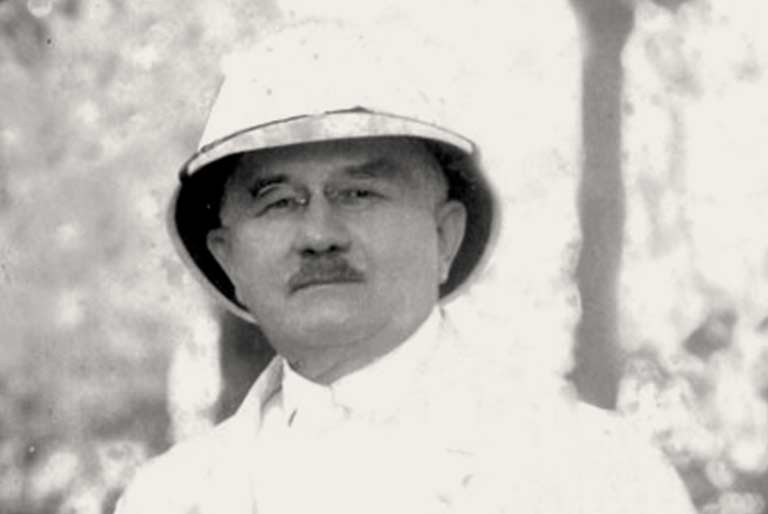
Louis Finot, French archaeologist
Early life
Jayavarman VII was born in Angkor to King Dharaindravarman II (r. 1150–1160) and Queen Sri Jayarajacudamini. He belonged to a lineage of affluent rulers and enjoyed a privileged upbringing. He followed the tradition of his father in being a Mahayana Buddhist. Mahayana Buddhism is one of two main branches of Buddhism, comprising many schools and reinterpretations of fundamental human values, ideals and beliefs not limited to Buddhist teachings. Coming from a family of considerable influence, Jayavarman had the advantage of political connections early on. He married Princess Jayarajadevi and upon her death, married her sister Indradevi.
Conquests and rulership
After his father's death in 1160, Jayarvaman VII, who was around forty years old then, became a courtier. While it is known that he left Angkor in 1166, it is not confirmed whether he went to the Kompong Savy province around 60 miles from the Khmer capital or to a Cham kingdom.
From the 2nd to the mid-15th century, the Cham inhabited Champa, a collection of independent polities in central and southern Vietnam. In the 12th century, the Cham fought a series of battles with the Khmer Empire.
In 1177 and 1178, the Cham waged war against the Khmer Empire. Champa King Jaya Indravarman IV attacked the Khmer capital without warning by leading a fleet up the Mekong River and Siem Reap River. The Cham army looted the capital and killed King Tribhuvanadityavarman.
In 1178, Jayavarman, now in his fifties, led the Khmer army against the invaders and successfully fended them off. He returned to the capital, negotiated with opposing factions and in 1181, Jayavarman VII ascended the throne of the Khmer Empire. It is possible that he may have fended off another Cham invasion and squashed a rebellion of the Kingdom of Malyang, modern-day Battambang in northwestern Cambodia.
Jayavarman was an astute political leader and was fortunate in building alliances to defeat his enemies. He also benefitted from the military skill of Prince Sri Vidyanandana, who arrived to the Khmer capital as a refugee in 1182. Jayavarman accorded the young man the status of a prince, educating him in all branches of knowledge and weaponry. Vidyanandana played an instrumental role in suppressing the Malyang revolt against Jayavarman VII. In 1190, Vidyanandana joined the war against Champa, seized the capital Vijaya, held King Jaya Indravarman IV as prisoner, and declared himself king. In 1191, he faced a revolt in Vijaya and was forced to flee to Cambodia, with Jaya Indravarman V taking the throne. Vidyanandana returned to slay Jaya Indravarman IV and Jaya Indravarman V, and became the unopposed ruler of Champa.

Angkor Thom
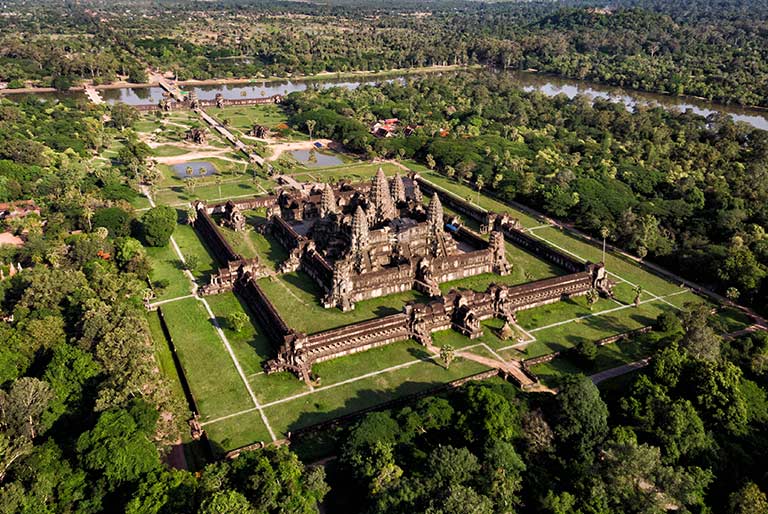
Angkor Wat
The capital city of Angkor Thom lies on the banks of the Siem Reap River, its south gate is located to the north of Siem Reap and about a mile north of the entrance to the famous Angkor Wat, the largest religious monument in the world, originally constructed as a Hindu temple dedicated to Vishnu.
Angkor Thom was envisioned as the centerpiece of Jayavarman's building program. An inscription in the city describes the king as the groom and the city as his bride. Angkor Thom was not the first Khmer capital. Parts of Angkor Thom overlap the original capital of Yasodharapura. The capital city had a canal system with water flowing from the northeast to the southwest.
Khmer's Politics and Religions
Prior to Jayavarman's ascension to the throne, Khmer was a stratified clan-based society without a continuing governance framework and a single central authority. The clan-based groups comprised of bonded workers 'ruled' by classes of equal or higher status. A group of regional estates formed small kingdoms that would initiate or break alliances in their clashes with neighboring kingdoms, resulting in a loss of property and life.
Jayavarman VII took control of individual provinces and unified them under his empire. Historians have suggested a three-stage model behind the development of the Khmer empire. First are local units headed by native chieftains, second, a consolidation into bigger regional units with 'rajas' or petty kings, and third, a merging into larger states governed by a central authority.
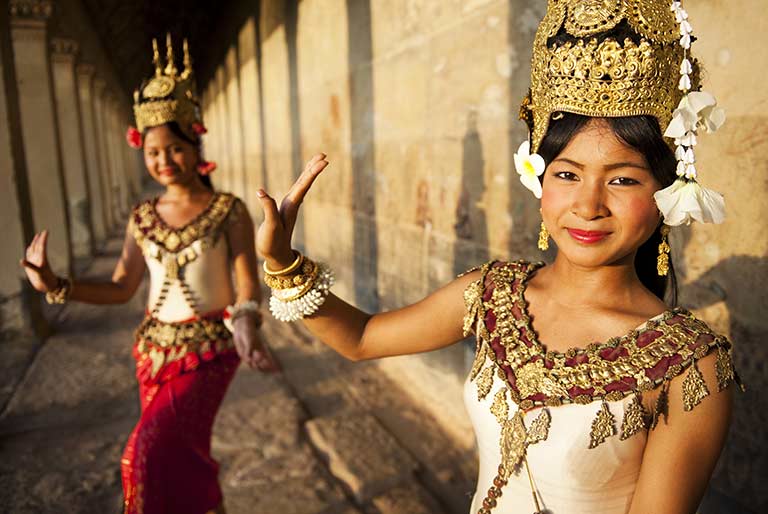
Khmer apsara dance
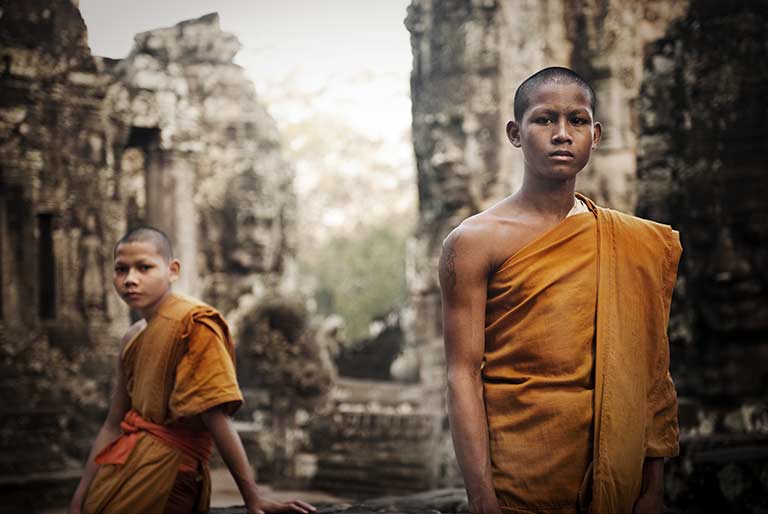
Khmer Monks
Deification (becoming like god) is a feature of the transition from lower to the upper stages of authority. The chieftain would rise to the role of king and then a divine king. Khmer kings also likely followed a feature of the Indian political structure known as 'mandalification', which believed that a ruler who was properly consecrated could create a 'mandala' or a sacred realm, controlling the realm as the central Buddha while his advisors would serve as attendant bodhisattvas.
Much of Khmer's official inscriptions and religious messages used Sanskrit and Indian languages. Relations between India and Cambodia were a source of influence, leading locals to adopt Indian religions. That said, Jayavarman VII placed Buddhism at the apex of the Khmer religious system, and expressed his devotion in his construction of religious structures. Regard for Hinduism and Brahminical authority was ingrained in his actions; he commissioned statues of his teacher and other depicting Indian puja rituals. A notable one is the Prasat Tor inscription from 1189 with Hindu inscriptions heralding Jayavarman as a personification of Shiva, and invoking Hindu doctrines and myths, with a few references to Buddhist monasteries.
It appears as if both religions co-existed as separate institutions under his rulership. However, competition and conflict between Buddhism and Hinduism prevailed, and reared after Jayavarman's reign, when statues and depictions of the Buddha were destroyed in important Angkor temples.
Contribution to Public Health and Infrastructure
During his reign, Jayavarman VII constructed 102 hospitals and many roads and reservoirs. The inscription at Say Fong states: "He suffered the illnesses of his subjects more than his own; because it is the pain of the public that is the pain of kings rather than their own pain."
Jayavarman VII established a network of roads linking Angkor Thom with Champa and Phimai, present-day township in northeast Thailand. Travelers enjoyed the convenience of a rest house every 9 miles, and a total of 121 rest houses. Most were erected on the route from Angkor Thom to Champa, while the rest were distributed on the road from Angkor Thom to Phimai, at Phnom Chiso and along other routes.
Construction of Temples and Religious Buildings
Jayavarman VII was a tolerant leader, accepting of Hinduism, a reason being that his first wife worshipped Buddha, Shiva and Vishnu. He built numerous temples, religious buildings and public works.
Khmer art drew from external influences but differentiated itself, as is evident in the representations of rulers and gods with Khmer facial features. The bronze statues and ritual objects in the royal palace, temples and the private chapels of courtiers are also recognizably Khmer in their facial features, dress and adornment. Lost-wax casting was used to craft the objects. It is the process where molten metal is poured into a mold created using a wax model. Once the mold is ready, the wax model is melted and the molten metal is poured into the space left by the drained wax.
In 1186, Jayavarman constructed the Ta Prohm temple at Angkor, and installed his mother's statue there, as Prajnaparamita or "Great Mother" in Mahayana Buddhism. Jayavarman VII proceeded to build the Preah Khan temple five years later, and installed a statue of his father in the likeness of Lokesvara, a form of the peaceful and compassionate bodhisattva. He also founded the Neak Pean temple at the center of the artificial lake Jayatataka Baray, and placed the statue of Bhaisajyaguru, the healing Buddha.

Ta Prohm temple at Angkor

Neak Pean temple
Towards the end of his reign, Jayavarman VII constructed the Bayon temple at the center of his walled capital. It was last state temple to be built at Angkor and the only Angkorian state temple that was dedicated primarily to the Buddha. The temple is richly decorated, its most distinctive feature being the 216 serenely smiling stone faces on the towers that protrude from the terrace and form a cluster around its central peak.
The similarity of the faces has encouraged many scholars to posit that they are representations of Jayavarman VII. Some others believe that the faces bear a likeness to Lokesvara. The two conclusions may be linked, as George Coedès, 10th century French scholar of southeast Asian archaeology and history, theorizes. Coedès says that Jayavarman considered himself as a 'devaraja' or god-king, in continuation with the beliefs of Khmer kings before him. The difference was that while his predecessors followed Hinduism and believed that they and Shiva were of the same substance, Jayavarman identified himself with the Buddha.

Wat Nokor Bachey
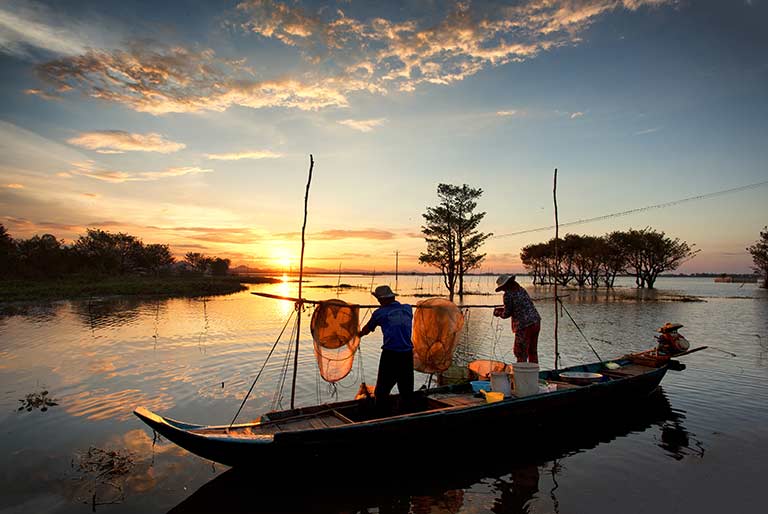
Siem Reap River
Of architectural importance is the Wat Nokor Bachey, also built during the last years of Jayavarman's rule and believed to be his headquarters for a period of time. A distinctive feature of the temple is its black sandstone construction, setting it apart from the brick or red sandstone temples of the time. An interesting legend attributed to the temple goes like this: the temple was constructed by a king who upon accidently killing his father, wed his mother, not being fully aware of their relationship with him. After learning of his crime, he built the temple in atonement for his mistake.